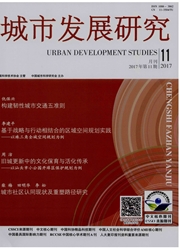

 中文摘要:
中文摘要:
以杭州作为研究实例,结合空间正义原则和发达国家在保障房建设上的成功经验,通过调查杭州现有公租房与在建公租房项目的居住空间特征,分析杭州公租房在空间布局、空间组织和空间融合上存在的问题,提出优化对策。研究方法:利用文献资料分析法得到空间正义的内涵要义、居住空间的研究维度以及国外保障房居住空间的成功经验;通过实地调研分析得到杭州公租房居住空间特征;基于空间正义原则和公租房居住空间现状特征,运用比较研究方法得到杭州公租房的问题及对策。主要结论为:(1)杭州公租房在空间区住上表现出选址偏远、分布集中、交通服务水平不高、住户职住分离现象突出、医疗卫生和教育设施不健全、休闲娱乐设施缺乏等特征,在空间组织上对内缺少公共的交往空间、文化建设不足,对外缺乏与附近社区和城市中心的联系,在空间融合上存在居住空间分异明显、不同阶层沟通交流不足的问题;(2)根据空间正义观念和杭州公租房现存问题,日后应从保证住户在就业机会、医疗教育服务和商服娱乐设施的可及性,加强住区内部空间组织及其与外部空间的联系,促进社会融合等方面着手优化公租房的居住空间。
 英文摘要:
英文摘要:
Taking Hangzhou as a case study, based on the successful experience of developed countries and regions in low-income housing construction and personal research about public rental housing households' spatial needs and current living status as well as spatial characteristics of new public rental housing projects under construction, combined with basic principles of spatial justice, this paper analyzed the existing problems in the spatial distribution of Hangzhou's public rental housing and put forward some optimization strategies. The main conclusions are as followed: firstly, projections of Hangzhou's public rental housing show a lot problems in spatial location, including remote site, centralized distribution, poor transportation service, prominent separation between workshop and residence, insufficient medical, educational and recreational facilities; secondly, as far as spatial organization is concerned, public rental housing generally lacks public communication space and cultural construction as well as external links with surrounding communities and city center; thirdly, significant residential differentiation and limiting communication among different classes hamper social integration; finally, according to the concept of spatial justice and existing problems of public rental housing, Hangzhou should ensure the accessibility of employment, medical and educational services as well as entertainment facilities, strengthen interior spatial organization as well as its relationship with external society and try to promote social integration to optimize the living space of public rental housing in the future.
 同期刊论文项目
同期刊论文项目
 同项目期刊论文
同项目期刊论文
 期刊信息
期刊信息
